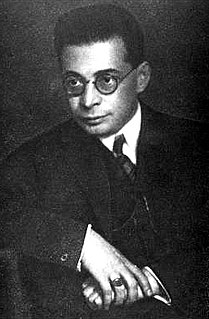Related Research Articles

Sigmund Freud was an Austrian neurologist and the founder of psychoanalysis, a clinical method for treating psychopathology through dialogue between a patient and a psychoanalyst.

Sándor Ferenczi was a Hungarian psychoanalyst, a key theorist of the psychoanalytic school and a close associate of Sigmund Freud.

Otto Rank was an Austrian psychoanalyst, writer, and philosopher. Born in Vienna, he was one of Sigmund Freud's closest colleagues for 20 years, a prolific writer on psychoanalytic themes, editor of the two leading analytic journals of the era, managing director of Freud's publishing house, and a creative theorist and therapist. In 1926, Rank left Vienna for Paris and, for the remainder of his life, led a successful career as a lecturer, writer, and therapist in France and the United States.
Introjection is a psychology term that describes the human tendency to imitate others. It refers specifically to the subconscious adoption of the thoughts or personality traits of others who seem more capable.
Anal eroticism, in psychoanalysis, is sensuous pleasure derived from anal sensations. Sigmund Freud, the founder of psychoanalysis, hypothesized that the anal stage of childhood psychosexual development was marked by the predominance of anal eroticism.

Michael Balint was a Hungarian psychoanalyst who spent most of his adult life in England. He was a proponent of the Object Relations school.

Maria Torok was a French psychoanalyst of Hungarian descent.
Identification with the Aggressor is one of the forms of identification conceptualized by psychoanalysis. Specifically, it is a defence mechanism that indicates taking the role of the aggressor and his functional attributes, or imitating his aggressive and behavioral modality, when a psychological trauma brings about the hopeless dilemma of being either a victim or an abuser.
Martin Stanton is a British writer, teacher and psychoanalyst.
The Independent or Middle Group of British analysts represents one of the three distinct sub-schools of the British Psychoanalytical Society, and 'developed what is known as the British independent perspective, which argued that the primary motivation of the child is object-seeking rather than drive gratification'. The 'Independent group...is strongly associated with the concept of countertransference as well as with a seemingly pragmatic, anti-theoretical attitude to psychoanalysis'.
Neutrality is an essential part of the analyst's attitude during treatment, developed as part of the non-directive, evenly suspended listening which Freud used to complement the patient's free association in the talking cure.
Claude Nachin is a French psychiatrist and psychoanalyst, the majority of whose writings have affiliations with the joint work of Nicolas Abraham and Maria Torok, particularly with respect to their concept of the intergenerational "phantom".
Sandor Rado was a Hungarian psychoanalyst of the second generation, who moved to the United States of America in the thirties.
True self and false self are psychological concepts, originally introduced into psychoanalysis in 1960 by Donald Winnicott. Winnicott used true self to describe a sense of self based on spontaneous authentic experience and a feeling of being alive, having a real self. The false self, by contrast, Winnicott saw as a defensive façade, which in extreme cases could leave its holders lacking spontaneity and feeling dead and empty, behind a mere appearance of being real.
Neville Symington was a member of the Middle Group of British Psychoanalysts which argues that the primary motivation of the child is object-seeking rather than drive gratification. He published a number of books on psychoanalytic topics, and was President of the Australian Psychoanalytical Society from 1999 to 2002.

Hanns Sachs was one of the earliest psychoanalysts, and a close personal friend of Sigmund Freud. He became a member of Freud's Secret Committee of six in 1912, Freud describing him as one "in whom my confidence is unlimited in spite of the shortness of our acquaintance".
In children, narcissistic withdrawal may be described as 'a form of omnipotent narcissism characterised by the turning away from parental figures and by the fantasy that essential needs can be satisfied by the individual alone'.

Henry Z'vi Lothane, M.D., is a Polish-born American psychiatrist, psychoanalyst, educator and author. Lothane is currently Clinical Professor at Icahn School of Medicine at Mount Sinai, New York City, specializing in the area of psychotherapy. He is the author of some eighty scholarly articles and reviews on various topics in psychiatry, psychoanalysis and the history of psychotherapy, as well as the author of a book on the famous Schreber case, entitled In Defense of Schreber: Soul Murder and Psychiatry. In Defense of Schreber examines the life and work of Daniel Paul Schreber against the background of 19th and early 20th century psychiatry and psychoanalysis.

Basic Fault Theory was proposed by Michael Balint, and alludes to an individual's inability to form healthy relationships due to unresolved dependency issues from early childhood in relation to the formation of object reactions in an effort to deal with a lack of adjustment between their psychological needs and the lack or negative care provided by someone close to them.
Alice Balint was a Hungarian psychoanalyst.
References
- ↑ Richard Sterba, The First Dictionary of Psychoanalysis (2013) p. 27
- ↑ E. Auchinloss, Psychoanalytic Terms and Concepts (2012) p. 140
- ↑ S. Flanders, Reading French Psychoanalysis (2014) p. 570
- ↑ Michael Balint, Primary Love and Psychoanalytic Technique (2013)
- ↑ N. Symington, Narcissism (1993) p. 55